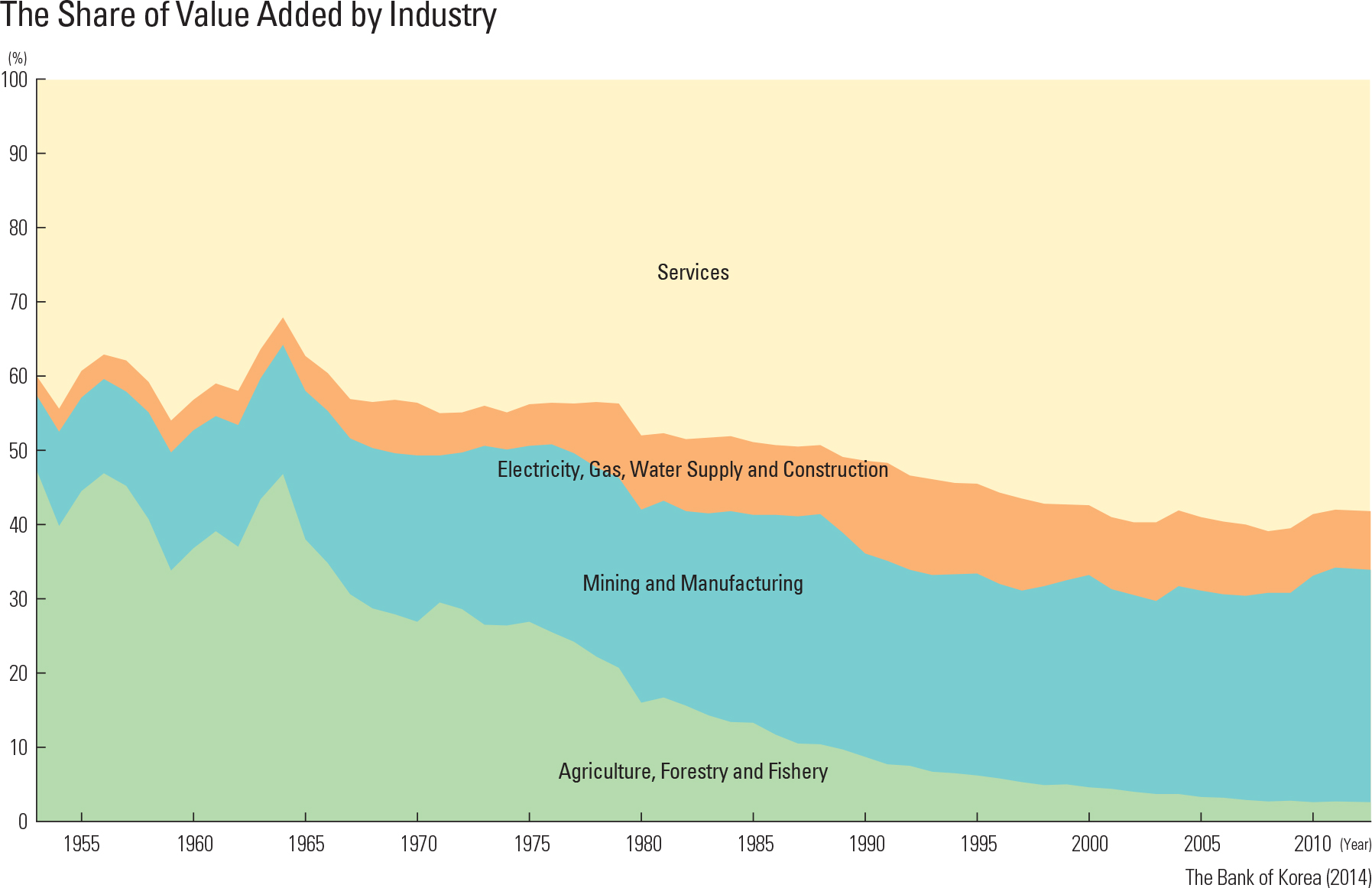The economic transition in Korea over the past 60 years can be easily attributed to both industrialization and globalization. As its industrial structure progressed rapidly from the incorporation of primary industries to the inclusion of secondary and tertiary industries, Korea achieved highly compressed economic growth. The industrial policy, especially in light of the government’s export-oriented development strategies, was a success. However, as both internal and external circumstances have changed since the 1980s, restructuring became necessary; efforts to develop intellectual talent and to conduct research and development activities were made across all industries. The government focused on fostering the private sector; and as a result, the status of chaebols (Korean conglomerates) grew continuously.
Assessing Korea’s economic status through the interpretation of its national GDP in world rankings indicates an upward trend. Korea was ranked 31st in 1960, 41st in 1965, 32nd in 1970, and 30th in 1975. It then steadily moved up to 28th in 1980, 18th in 1985, 15th in 1990, and 11th in 1995. It has been residing in the 12th-15th range for the last decade. Since the founding of the Republic of Korea in 1948 until the early 1960s, Korea’s economy depended primarily on agriculture, and its economic system and industrial structure resembled that of other underdeveloped countries. During that period, agriculture, forestry, and fishery accounted for more than 40% of domestic production and more than 60% of employment. On the other hand, manufacturing accounted for less than 20% of domestic production, and less than 10% of employment. This lack of manufacturing was due to the fact that under the Japanese colonial government the main facilities needed for war activities were located in North Korea. Additionally, those manufacturing facilities that were located in the South were heavily damaged during the Korean War. The 1950s post-war years ushered in a time of political, economic, and social confusion.
Since the early 1960s, Korea began to focus on economic growth through industrialization, and it was during this time that manufacturing became the key to Korea’s economic development. During the Park Chung-hee administration, which began in 1961, economic development was placed at the center of its agenda when the Five-year Economic Development Plan was enacted in 1962. Export-led industrialization and economic growth were the new strategic foci, and the government-led industrial development policy was emphasized. In the 1960s, an export-led strategy based on light industries was promoted with fabric, plywood, wigs, and shoes becoming the main exports. In the 1970s, the government began to promote heavy chemical industries and the main industrial focus shifted from light to heavy industries overall. The export products changed as well. In the early 1960s, minerals and raw silk were on the top of the list; however, these were replaced by fiber, clothing, and shoes between 1970 and 1980. After 1990, high technology products such as semiconductors and computers became important exports.
The economic growth trend indicated through changes in the nation’s GDP real growth rate reveals that it increased from 4% in the pre-1960s to 8.4% in the 1960s; it increased to 9.0% in the 1970s and to 9.7% in the 1980s. This trend indicates that a high growth rate of 10% was sustained for a considerable period. Manufacturing, in particular, maintained a well above 10% average annual growth rate at 16.8% in the 1960s, 15.8% in the 1970s, and 12.2% in the 1980s even with decadal fluctuations. The high growth was especially visible from the early 1960s to mid-1970s. This pace slowed down after that and dropped to 6.5% in the 1990s and to a mere 4% in the 2000s. The significant drop came during the 1979 Oil Crisis, the Asian foreign exchange crisis in 1997, and the 2008 global financial crisis when the real growth rate of manufacturing industry recorded a negative trend. However, it soon recovered through successful economic restructuring and once again realized growth even though the rate has been somewhat impaired. Agriculture, forestry, and fishery dropped from 40% in the 1950s to 3% in the 2000s while that of manufacturing increased from 12% to 27.4% during the same period. The service industry has soared from 41.1% to 59.5%. This implies that Korea’s industrial structure rapidly shifted from primary to secondary and tertiary industries. Light industry led overall industrial growth between 1950 and 1970; however, it was surpassed by the heavy chemical industry, which rapidly grew since 1970.
The success in industrialization and globalization greatly impacted the national landscape. As a result, both industrial growth and population settlement concentrated in the greater capital area while major industries developed mainly along the Gyeongbu Axis. The governmentled industrial policy, which began in 1960, resulted in growth pole development in certain areas, and the exportled industrial development occurred in the southeastern coastal cities due to their designation as export import industrial centers. As a corrective measure to such imbalanced growth, factory regulation in the capital area was instituted, industrial facilities were relocated to rural areas, and local businesses were fostered through the implementation of balanced growth policies.

